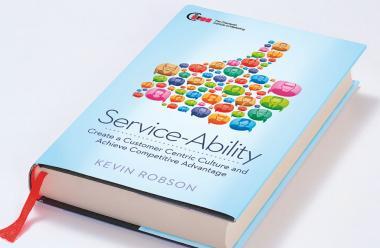They say that only President Richard Nixon, the staunch anti-communist, could have gone to communist China in order to build on the better relations between the two countries. Similarly, will a UK marketer from a country internationally known for frosty customer service, explain to the world how to serve customers better? If so, will that marketer be Kevin Robson, the author of ‘Service-Ability’?
In his book, Robson makes the central argument that the average organisation is modelled on the out-dated corporate structure inherited from the industrial revolution. Robson asserts that far from freeing up employees, technology has enslaved them; enabling the creation of call centres that have put the most important relationship of all, that with the customer, at the hands of disenfranchised wage slaves.
Much of Robson’s ire is directed towards large corporations, and he refers to a number of larger organisations (General Motors, Hewlett Packard, Southwest Airlines, British Airways, Tesco, United Airlines, Google, and Nissan). Robson also mentioned 9/11 to illustrate a point about customer loyalty in adverse times, but this jarred a little upon reading.
In the first half of the book, the author makes extended reference to well-known marketing research and academic theory (Maslow, Herzberg, Porter, Handy, and Hammer). Robson is also a fan of other peoples’ lists; Konosuke Matsushita’s five principles, Lowe and McBean six fears, and the four elements of Kaplan and Norton’s Balanced Scorecard are all reproduced. Much of this will be familiar to the target audience, and it is unclear whom these recaps are designed to benefit.
The slow, majestic procession through industrial history at the start of the book is excessively long, and it contrasts sharply with the furious narrative gallop towards the end, where the author includes a mere page-and-a-half on the importance of company values. This probably says more about the author’s interests than it does about the relative value of each section to the book’s central argument. That said, towards the end of the book Robson makes a powerful plea for more enlightened, servant leadership, and his rallying cry for true employee empowerment is well made.
Halfway through the book Robson introduces a visualisation that combines the strands of ‘Service-Ability’ to create a diagnostic tool of four quarters. In its current form, the diagram is likely to be too complex and cumbersome to become widely adopted by the marketing community. Should the book reach a second edition; the author may wish to consider including a simplified version of this diagram much earlier on in the text. Robson would then be free to use the rest of the book to examine and illustrate, with real-life examples, each quarter in detail.
More than once Robson quotes a full-page passage from another book. ‘Service-Ability’ is in need of some judicious editing (and proofreading too). The book could be tighter and deliver more impact. Tellingly, the companion website gets the concept of ‘Service-Ability’ across more effectively and succinctly than the book itself.
In all, readers that are already familiar with common marketing theory are likely to find this book a frustrating read. ‘Service-Ability’ is based on an interesting, although not groundbreaking, central theory but the message struggles to break free from the book’s flawed structure and lack of narrative balance.
Join our Book Club. If you're a member of The Marketing Society we'd love you to write a 300-word review for our Clubhouse. Or if you're an author get in touch. We've got lots of members keen to review your book.
Contact Michael Piggott to find out more.
Newsletter
Enjoy this? Get more.
Our monthly newsletter, The Edit, curates the very best of our latest content including articles, podcasts, video.
Become a member
Not a member yet?
Now it's time for you and your team to get involved. Get access to world-class events, exclusive publications, professional development, partner discounts and the chance to grow your network.

